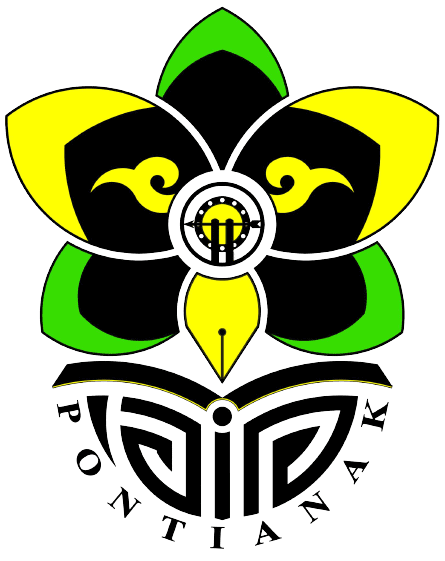A Multimodal Thematic Teaching Material Application for Supporting Blended Learning In Elementary Education
DOI:
https://doi.org/10.24260/arfannur.v5i3.3535Keywords:
multimodal, teaching material, elementary educationAbstract
This research is motivated by the conditions in the field where so far the teacher teaches still using printed teaching materials, and other separate learning resources that must be prepared in advance and are not yet available in the package books used so that the teaching materials are less practical and complete, related to this condition, the researcher aims to develop a Multi Modal Teaching Material Application Product with the object of developing Thematic Teaching Materials in grade 5 Elementary School / Madrasah Ibtidaiyah. The method used is the R&D model with 4D steps according to Tagarajan. Starting from the stages of defining, designing, developing, and distributing products. But in this study it is only limited to producing products only (Product Validation) the next stage is carried out in the next study. The techniques used include discussions with experts on product design, distributing Product Validation questionnaires. The data obtained were then analyzed using qualitative and quantitative approaches. The results showed that multimodal teaching materials were developed by involving 8 PGMI students. Products validated by experts, consisting of 8 media experts and learning material experts. The results showed data Validation of product feasibility of 3.94 or 98.2% with a very feasible category. Product feasibility validation data from the media aspect shows 3.97 or 99% with a very feasible category. Product feasibility validation data from the material content aspect shows a value of 3.94 or 98.5%, a value indicating that the material in this application is very feasible. So it can be concluded that the multimodal teaching materials developed have a level of feasibility as a product Multimodal teaching materials show very feasible results as Multimodal Thematic Teaching Material Applications and can be continued in the next research hold from the R & D ledge Test practicality and effectiveness in limited and widespread fields to then be distributed as Teaching Materials in the field
Downloads
References
Al Fajri, T. A. (2018). PENTINGNYA PENGGUNAAN PENDEKATAN MULTIMODAL DALAM PEMBELAJARAN. WASKITA: Jurnal Pendidikan Nilai dan Pembangunan Karakter, 2(1), 57–72. https://doi.org/10.21776/ub.waskita.2018.002.01.5
Arizona, K., Abidin, Z., & Rumansyah, R. (2020). PEMBELAJARAN ONLINE BERBASIS PROYEK SALAH SATU SOLUSI KEGIATAN BELAJAR MENGAJAR DI TENGAH PANDEMI COVID-19. Jurnal Ilmiah Profesi Pendidikan, 5(1), 64–70. https://doi.org/10.29303/jipp.v5i1.111
Dewi, W. A. F. (2020). Dampak COVID-19 terhadap Implementasi Pembelajaran Daring di Sekolah Dasar. EDUKATIF : JURNAL ILMU PENDIDIKAN, 2(1), 55–61. https://doi.org/10.31004/edukatif.v2i1.89
Drake, S. M. (2007). Creating Standards-Based Integrated Curriculum: Aligning Curriculum, Content, Assessment, and Instruction. ERIC.
Graham, C. R. (2006). Blended learning systems. The Handbook of Blended Learning: Global Perspectives, Local Designs, 1, 3–21.
Hanifah Salsabila, U., Irna Sari, L., Haibati Lathif, K., Puji Lestari, A., & Ayuning, A. (2020). Peran Teknologi Dalam Pembelajaran Di Masa Pandemi Covid-19. Al-Mutharahah: Jurnal Penelitian Dan Kajian Sosial Keagamaan, 17(2), 188–198. https://doi.org/10.46781/al-mutharahah.v17i2.138
Istiqomah, K., Setyaningrum, V., & Atmaja, D. S. (2023). Pengembangan Bahan Ajar Chatbot Berbasis Artificial Intelligence Materi Sistem Peredaran Darah Manusia Kelas V. Perspektif Pendidikan dan Keguruan, 14(1), 50–56. https://doi.org/10.25299/perspektif.2023.vol14(1).12455
Lestari, T., Nurhanurawati, Caswita, & Yulianti, D. (2023). Thematic Teaching Materials Using Science, Technology, Engineering and Mathematics Approaches to Improve Problems Solving Ability of Elementary School Students. Jurnal Penelitian Dan Pengembangan Pendidikan, 7(1), 126–134. https://doi.org/10.23887/jppp.v7i1.60361
Lim, C. P., & Wang, L. (2016). Blended learning for quality higher education: Selected case studies on implementation from Asia-Pacific. UNESCO Bangkok Office.
Mayer, R. E. (2014). Incorporating motivation into multimedia learning. Learning and Instruction, 29, 171–173.
Rogantina, M. A. (2017). Peran Dan Fungsi Teknologi Dalam Peningkatan Kualitas Pembelajaran. Jurnal Ilmiah Research Sains, 3(No.1), 122–129.
Sabran, S., & Sabara, E. (2018). Keefektifan Google Classroom sebagai media pembelajaran. PROSIDING SEMINAR NASIONAL LEMBAGA PENELITIAN UNIVERSITAS NEGERI MAKASSAR, 2, 122–125.
Sari, E. D. W. (2021). PEMANFAATAN SUMBER BELAJAR PADA PEMBELAJARAN TEMATIK KELAS II DI MADRASAH IBTIDAIYAH AL-HASIB PAKIS KABUPATEN MALANG [Sarjana Thesis]. UNIVERSITAS ISLAM MALANG.
Setyaningrum, V., Erlina, E., & Thongsan, N. C. (2023). Developing a chatbot in quantities, denomination, and measurement: An artificial intelligence-based teaching materials. THABIEA : JOURNAL OF NATURAL SCIENCE TEACHING, 6(2), 132. https://doi.org/10.21043/thabiea.v6i2.23487
Singh, V., & Thurman, A. (2019). How many ways can we define online learning? A systematic literature review of definitions of online learning (1988-2018). American Journal of Distance Education, 33(4), 289–306.
Sugiyono. (2010). Sugiyono. (2010). Metode Penelitian Pendidikan. Cetakan ke 10. CV. Alfabeta, Bandung. (10th ed.). CV Alfabeta.
Thiagarajan, S., Dorothy S, S., & Melvin I, S. (1974). Instructional Development for Training Teachers of Expectional Children. Leadership Training Institute/Special Education: University of Minnesota.
Triningsih, R., Usman, H., & Pramono, A. W. (2023). KAJIAN LITERATUR PENGEMBANGAN BAHAN AJAR TEMATIK PADA SISWA SEKOLAH DASAR. Jurnal Administrasi Pendidikan, 20(1), 111–120.
Wardani, N. F. K., Sunardi, S., & Suharno, S. (2020). Context-Based Thematic Teaching Materials to Improve Elementary Students’ Learning Achievements. JPI (Jurnal Pendidikan Indonesia), 9(2), 193. https://doi.org/10.23887/jpi-undiksha.v9i2.22822
Yuliana, M., Wiryawan, S. A., & Riyadi. (2018). The development of thematic materials using project based learning for elementary school. Journal of Physics: Conference Series, 1022, 012018. https://doi.org/10.1088/1742-6596/1022/1/012018


